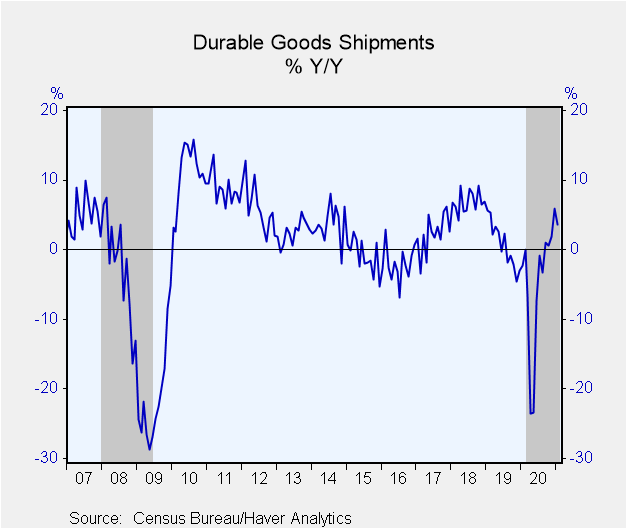 Global| Feb 25 2021
Global| Feb 25 2021Aircraft Orders Boost U.S. Durable Goods Orders in January
by:Sandy Batten
|in:Economy in Brief
Summary
• Orders increase a much larger-than-expected 3.4% m/m, led by a 148% m/m surge in aircraft orders. • Orders ex transportation up a solid 1.4% m/m. • Core capital shipments rise 2.1% m/m, offering a great start to Q1. Manufacturers' [...]
• Orders increase a much larger-than-expected 3.4% m/m, led by a 148% m/m surge in aircraft orders.
• Orders ex transportation up a solid 1.4% m/m.
• Core capital shipments rise 2.1% m/m, offering a great start to Q1.
Manufacturers' orders for durable goods increased a much larger-than-expected 3.4% m/m (4.5% y/y) in January following an upwardly revised 1.2% m/m gain in December (initially 0.2%). A 1.0% m/m gain had been expected by the Action Economics Forecast Survey. The January rise was the ninth consecutive monthly increase. New orders have risen 53% since their low in April.
Orders for nondefense capital goods excluding aircraft continued to firm last month, up 0.5% m/m (8.3% y/y) following an upwardly revised 1.5% m/m rise in December (initially 0.6%). It was the smallest of nine consecutive monthly increases.
Orders for transportation equipment jumped up 7.8% m/m (0.1% y/y) in January after having edged up 0.1% m/m in December. The rebound was led by a 148% m/m surge in aircraft orders, which included a 390% explosion of nondefense aircraft orders reflecting the return of the Boeing 737 MAX. Orders for motor vehicles and parts slipped 0.8% m/m. Orders for electrical equipment and appliances jumped up 4.2% m/m while orders for computers and electronic products fell 0.7% m/m.
Total shipments rose a solid 2.0% m/m (3.5% y/y) on top of an upwardly revised 2.1% increase in December (initially 1.4%). Shipments of core capital goods, a reliable coincident indicator of business spending on equipment in the national accounts, jumped up 2.1% m/m (7.7% y/y) in January after an upwardly revised 1.0% m/m gain in December (initially 0.5%). This provided a very strong start to Q1 as the January level of core capital goods shipments was 12% annualized above the Q4 average. Shipments of transportation products increased 0.7% m/m on top of an upwardly revised 3.4% m/m surge in December (initially 2.7% y/y). Shipments excluding transportation rose 2.6% m/m following an upwardly revised 1.4% m/m gain in December (initially 0.8%).
Unfilled orders for durable goods edged up 0.1% m/m (-6.2% y/y) in January after a 0.2% m/m decline in December. Excluding transportation, order backlogs rose 0.5% m/m in January versus 1.1% in December.
Inventories of durable goods fell 0.3% m/m (+0.3% y/y) in January, their second consecutive decline after three monthly gains. Excluding transportation, inventories increased 0.3% m/m, their fifth consecutive monthly rise.
The durable goods figures are available in Haver's USECON database. The Action Economics consensus forecast figure is in the AS1REPNA database.
| Durable Goods NAICS Classification | Jan | Dec | Nov | Jan Y/Y % | 2020 | 2019 | 2018 |
|---|---|---|---|---|---|---|---|
| New Orders (SA, % chg) | 3.4 | 1.2 | 1.3 | 4.5 | -6.9 | -1.7 | 7.3 |
| Transportation | 7.8 | 0.1 | 2.0 | 0.1 | -20.0 | -5.3 | 9.5 |
| Total Excluding Transportation | 1.4 | 1.7 | 1.0 | 6.6 | 0.0 | 0.3 | 6.0 |
| Nondefense Capital Goods Excl. Aircraft | 0.5 | 1.5 | 1.2 | 8.3 | 1.8 | 1.7 | 4.7 |
| Shipments | 2.0 | 2.1 | 0.4 | 3.5 | -5.0 | 0.6 | 6.8 |
| Nondefense Capital Goods Excl. Aircraft | 2.1 | 1.0 | 0.4 | 7.7 | 0.5 | 2.4 | 5.8 |
| Unfilled Orders | 0.1 | -0.2 | 0.0 | -6.2 | -6.5 | -1.9 | 3.8 |
| Inventories | -0.3 | -0.2 | 0.9 | 0.3 | 0.7 | 4.1 | 5.3 |
Sandy Batten
AuthorMore in Author Profile »Sandy Batten has more than 30 years of experience analyzing industrial economies and financial markets and a wide range of experience across the financial services sector, government, and academia. Before joining Haver Analytics, Sandy was a Vice President and Senior Economist at Citibank; Senior Credit Market Analyst at CDC Investment Management, Managing Director at Bear Stearns, and Executive Director at JPMorgan. In 2008, Sandy was named the most accurate US forecaster by the National Association for Business Economics. He is a member of the New York Forecasters Club, NABE, and the American Economic Association. Prior to his time in the financial services sector, Sandy was a Research Officer at the Federal Reserve Bank of St. Louis, Senior Staff Economist on the President’s Council of Economic Advisors, Deputy Assistant Secretary for Economic Policy at the US Treasury, and Economist at the International Monetary Fund. Sandy has taught economics at St. Louis University, Denison University, and Muskingun College. He has published numerous peer-reviewed articles in a wide range of academic publications. He has a B.A. in economics from the University of Richmond and a M.A. and Ph.D. in economics from The Ohio State University.










